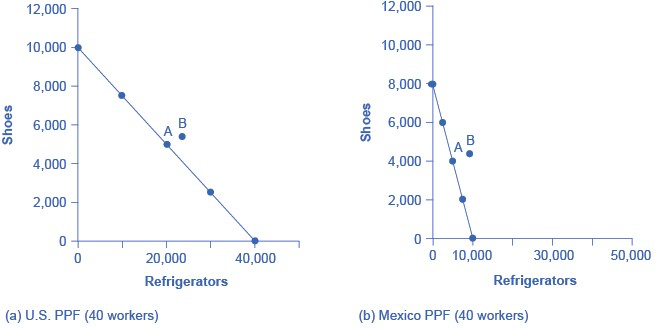Comparative Advantage and Mutually Beneficial Trade
How does Comparative Advantage give rise to Mutually Beneficial Trade?
- Marketing, Advertising, Sales & PR
- Accounting, Taxation, and Reporting
- Professionalism & Career Development
-
Law, Transactions, & Risk Management
Government, Legal System, Administrative Law, & Constitutional Law Legal Disputes - Civil & Criminal Law Agency Law HR, Employment, Labor, & Discrimination Business Entities, Corporate Governance & Ownership Business Transactions, Antitrust, & Securities Law Real Estate, Personal, & Intellectual Property Commercial Law: Contract, Payments, Security Interests, & Bankruptcy Consumer Protection Insurance & Risk Management Immigration Law Environmental Protection Law Inheritance, Estates, and Trusts
- Business Management & Operations
- Economics, Finance, & Analytics
How does Comparative Advantage give rise to Mutually Beneficial Trade?
When nations increase production in their area of comparative advantage and trade with each other, both countries can benefit. Again, the production possibility frontier is a useful tool to visualize this benefit.
As always, the slope of the production possibility frontier for each country is the opportunity cost of one refrigerator in terms of foregone shoe production–when labor is transferred from producing the latter to producing the former.

Let’s say that, in the situation before trade, each nation prefers to produce a combination of goods that is most favorable to it.
The remarkable insight of comparative advantage: is that, even when one country has an absolute advantage in all goods and another country has an absolute disadvantage in all goods, both countries can still benefit from trade. Even though the United States has an absolute advantage in producing both refrigerators and shoes, it makes economic sense for it to specialize in the good for which it has a comparative advantage. The United States will export refrigerators and in return import shoes.
Related Topics
- Trade Balance: Surplus and Deficit
- Mercantilism
- J Curve
- National Trade Data Bank
- Capital Account (Economics)
- Merchandise Trade Balance
- Current Account
- Income Payments
- Unilateral Transfer
- Is it better to have a trade surplus or a trade deficit?
- Export of Goods and Services and Percentage of GDP
- Heckscher-Ohlin Model
- Linder Hypothesis
- The Balance of Trade as a Balance of Payments
- National Savings and Investment Identity
- Circular Flow of Money
- Financial Capital
- Supply and Demand Sides for Financial Capital?
- Flow of Capital
- Domestic Saving and Investment Determine the Trade Balance
- National Savings Identity and Trade Deficits
- How the Business Cycle Affects Trade Balances
- Trade Balance or Trade Surplus
- Level of Trade
- Comparative Advantage
- Absolute Advantage
- Specialization and Gain from Trade
- Absolute Advantage in All Goods
- Production Possibilities Frontier and Comparative Advantage
- Comparative Advantage and Mutually Beneficial Trade
- Gain from Trade
- Opportunity Costs and International Trade
- Intra-Industry Trade
- Splitting Up the Value Chain
- How Economies of Scale Lead to Trading Advantages
- Protectionism
- Closed Economy
- Tariffs
- Double Column Tariff
- Import Quotas
- Double Column Tariff
- Infant Industry Theory
- National Interest Argument
- Race to the Bottom
- Anti-Dumping Laws
- Dumping
- Trade War
- Race to the Bottom
- Non-Tariff Barriers
- Effects of Trade Barriers
- Who Is Benefited and Who is Harmed by Protectionism?
- Infant Industry Theory for Restricting Imports
- What is the Anti-Dumping Argument for Restricting Imports?
- What is the Environmental Protection Argument for Restricting Imports?
- Race to the Bottom
- Unsafe Consumer Products Argument for Restricting Imports?
- National Interest Argument for Restricting Imports
- What is the WTO?
- What is the GATT?
- What are Free Trade Agreements?
- North American Free Trade Agreement
- Central European Free Trade Agreement
- General Agreement on Free Tariff and Trade (GATT)
- Common Market
- Common Market for Eastern and Southern Africa
- Central American Common Market
- Caribbean Community and Common Market
- What are Economic Unions?
- WTO
- International Monetary Fund
- World Economic Forum
- Inter-American Development Bank
- Davos World Economic Forum
- Chamber of Commerce
- Jackson Hole Economic Symposium